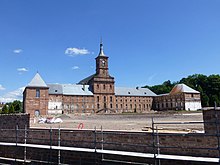Moyenmoutier Abbey
The abbey Moyenmoutier is a former Benedictine monastery in the town of Moyenmoutier in the Vosges department in the region of Grand Est (2015 Lorraine ) in France . It is located in the Vosges on the Rabodeau shortly before its confluence with the Meurthe , ten kilometers north of Saint-Dié-des-Vosges and around five kilometers west of Senones .
history
The abbey was founded around the year 671 (according to another statement around the year 800) by St. Hydulphe (Hidulf), a choir bishop from Trier . The name ( Medium Monasterium , Mittelmünster) is derived from the location between the abbeys Bonmoutier (dismantled), Saint-Dié, Étival and Senones . In the year 917 the Hungarians are said to have invaded the monastery. The monastery, which was newly built in 1345, fell into Kommende from 1535 to 1661 and flourished again in the 17th and 18th centuries, and the complex was rebuilt from 1765. In 1604 the abbey was a co-founder of the Benedictine Reform Congregation Saint-Vanne et Saint-Hydulphe . In the course of the French Revolution , the monastery was dissolved in 1792. The building served as a textile factory from 1806, but the impairing factory buildings in front of the T-shaped complex were demolished in the first decade of the 21st century and replaced by a French garden .
The buildings have been classified as Monument historique since 1840 and repeatedly later .
Buildings and plant
The complex is called "the most important monastic baroque building in the Vosges" (Reclam art guide).
The new construction of the Saint-Hydulphe abbey church , replacing a building consecrated in 1048, was completed in 1776. The architect was Ambroise Pierson , a Benedictine from Senones. The church has considerable dimensions with a length of 60 m and 30 m high. The vestibule of the church connects the two tracts of the not yet restored abbey (in the north the ladies tract for visitors). The church itself is a pillared church with a not protruding transept, a blind pendent dome over the crossing and a polygonal closed choir .
The choir stalls from 1698 with scenes of St. Hydulphe and representation of the cardinal virtues (classified as Monument historique since 1907) was taken from the previous building. The organ case that had been sold was copied in the 19th century.
The choir grille with the coat of arms of the Benedictine congregation of Saint-Vanne and Saint-Hydulphe (classified as a Monument historique since 1965) separates the nave from the vestibule.
In the Saint-Grégoire chapel there is a Carolingian sarcophagus attributed to the holy Hydulphe.
Individual evidence
- ↑ Reclam's Art Guide France III p. 289
- ^ Abbey Maria Laach (ed.): Benedictine monastery life in Germany, Berlin: Sankt Augustinus Verlag 1929, p. 96
literature
- Peter Volkelt, Horst van Hees: Reclam's art guide France III: Lorraine, Ardennes, Eastern Champagne. Philipp Reclam jun., Stuttgart 1983, ISBN 3-15-010319-3 , p. 289 f.
Web links
- [1] Website about the former abbey with tourist information
- Entry no.PA00107210 in the Base Mérimée of the French Ministry of Culture (French)
Coordinates: 48 ° 22 ′ 43.4 " N , 6 ° 54 ′ 46.1" E








